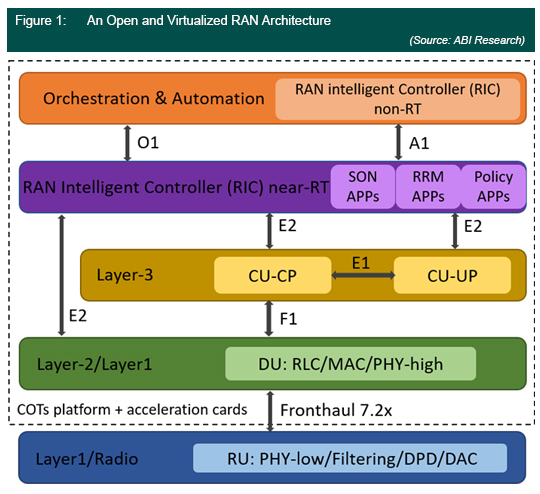The Development Status
|
NEWS
|
As Open Radio Access Network (Open RAN) is gaining momentum, the community at the same time has started promoting the microservice-based Radio Intelligent Controller (RIC) platform, which allows MNOs to implement external applications, called xAPPs, to control parts of their radio equipment to get access to the full benefits of network virtualization and Open RAN. The RIC platform features a cloud-native architecture, which supports active clustering for scalability, performance, and high availability of non-Real-Time (RT) and near-RT operations, including network configuration and life cycle management, intelligent beam optimization, Radio Resource Management (RRM), Self-Organized Networking (SON), and many others. Figure 1 gives an open and virtualized RAN architecture together with the RIC platform to run non-RT and near-RT applications.

As shown in the figure, the RIC platform is designed for MNOs to control a clustered RAN equipment, including radio, distributed, and centralized units via E2 interface, consistent with the O-RAN Alliance architecture to deliver efficient and self-optimized network operations and management. By implementing xAPPs on top of the RIC platform to control radio equipment, MNOs can have full visibility of their RAN systems and efficient management capability of spectrum allocation and processing hardware distribution, therefore delivering new services and the optimal user experience in a timely manner.
In August 2020, the Open Networking Foundation (ONF) formulated its Software-Defined RAN (SD-RAN) project to pursue the creation of an open-source RIC platform, starting from near-RT RIC. Apart from that, the TIP Radio Intelligence and Automation (RIA) subgroup also devotes its energy to providing microservice-based applications, i.e., xAPPs, from multi-vendor solutions, which are responsible for RAN functionality that is used to optimize radio resource allocation and network application performance.
The Benefits of Near-RT RIC
|
IMPACT
|
Although the current development of near-RT RIC is still in the prototyping and trialing stages, it has the potential to demonstrate promising performance initially in terms of handover and load-balancing latency at scale. By leveraging Artificial Intelligence (AI) and Machine Learning (ML) algorithms, the near-RT RIC application development with Open RAN architecture will help MNOs deliver cost-effective and highly performed multi-vendor interoperable communication services promptly. In general, the application use cases of near-RT RIC can be summarized as below:
- Massive MIMO System Optimization: This implementation helps MNOs manage network operation complexity and improve spectral and energy efficiencies via smart interference management and beam adaptation, joint channel estimation and detection, and modified user scheduling and cellular association. Moreover, it can also assist in enabling fine-grained network slicing for individual mobile users.
- Traffic Steering and Load Balancing: From a network automation and assurance perspective, with appropriate AL/ML algorithms running on the RIC platform, mobility load balancing among different cells within a cluster allows the ability to more accurately anticipate the traffic load and changes, therefore avoiding cell congestion and improving network accessibility.
Compared to conventional, special purpose-built RAN solutions, disaggregating software from hardware and running network functions on the General-Purpose Processor (GPP) allow MNOs to create containerization, microservices, and network slicing to meet different connectivity needs. However, GPP-based hardware architecture, in general, is not energy efficient in comparison to a Special-Purpose Processor (SPP)-based solution if the same computing capability is assumed. AI/ML technology applied on top of the RIC platform is well-positioned to optimize RAN functions via xAPPs and lower energy costs of the GPP by reducing network computation complexity.
The Key to Business Success
|
RECOMMENDATIONS
|
MNOs, in collaboration with small/new vendors, are the main drivers to promote the open RIC platform. They advocate for powerful RIC, xAPP, and multi-vendor interoperability to help the market transform and unlock a handful of vendor-dominated telco supply chains. The implementation of such a strategy can catalyze the creation of an xAPP ecosystem and allow MNOs to add new services more quickly as well as offer a far superior customer experience. However, the third parties' development of xAPPs for network automation and intelligent radio control creates trust and willingness problems. ABI Research believes this impact introduces critical challenges that may stop many MNOs from adopting the new approach. On the other hand, it also accentuates the value of standardization and intensive test and field trials to create a common framework, therefore increasing the trust of MNOs to build smooth and secure multi-vendor interoperable open virtualized networks with intelligent RAN control.
The AI/ML-enabled applications running on the RIC platform leverage data analysis to help MNOs increase operational efficiency and improve dynamic resource management capability. These objectives require the models and real-time functions to be trained offline at non-RT RIC and resort to A1 interface to send optimization policies to near-RT RIC. Thus, MNOs can further understand and optimize the network via xAPPs. On the other hand, MNOs also need to have the ability to gain good data for the training process and run these power-hungry AI/ML algorithms on more effective processing systems, which are still immature but fast-developing. The coexisting with the legacy RAN infrastructure in the same areas covered by a traditional RAN vendor creates an additional challenge. This challenge could hold small/new vendors back from fully understanding MNOs' network conditions and gives the big vendor, which provided the legacy RAN infrastructure, the advantage to promote its RIC solution.
The promotion of the open RIC platform and its applications is not a short-term initiative. Forerunners, such as MNOs embracing the Open RAN approach, should start taking more active roles to create collaboration among different ecosystem partners for field trials and commercial launches. These actions will help them accumulate experience of taking full control of their network development and deployment, rather than purely relying on a community of network integrators to help build pre-packed networks.
